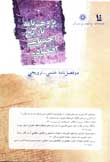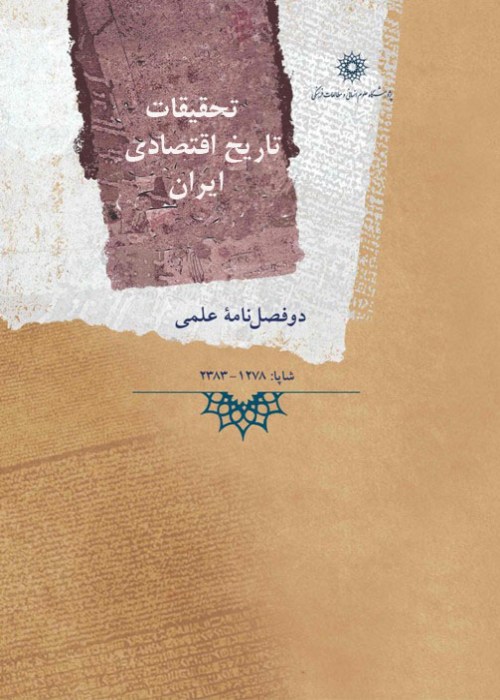فهرست مطالب

پژوهش نامه تاریخ اجتماعی و اقتصادی
سال ششم شماره 1 (پیاپی 11، بهار و تابستان 1396)
- تاریخ انتشار: 1396/06/26
- تعداد عناوین: 6
-
-
صفحات 1-24این پژوهش به یکی از موضوعات اجتماعی-اقتصادی در تاریخ معاصر ایران یعنی کارکرد اقتصادی نهاد خانواده در نقاط شهری کشور طی دو دهه پایانی حکومت پهلوی، می پردازد. چنان که سعی شده است تا با تمرکز بر روی برنامه نوسازی حکومت پهلوی دوم طی دوره زمانی موردنظر، ارتباط و همبستگی این برنامه با تغییر میزان کارکرد اقتصادی خانواده ایرانی را تبیین نماید. واکاوی این مسئله، با کاربرد یک نظریه جامعه شناسی یعنی تئوری مدرنیزاسیون، و از طریق روش پژوهش کمی یعنی مبتنی بر داده های عمدتا آماری و عددی انجام گردید، ضمن این که شیوه و ابزار گردآوری اطلاعات نیز مطالعه کتابخانه ای و اسنادی بوده، که با فیش برداری و محاسبه ارقام و داده های خام صورت پذیرفت. یافته های این تحقیق بیانگر این است، که رابطه منفی و معکوسی میان برنامه نوسازی حکومت پهلوی با کارکرد اقتصادی خانواده طی آن زمان وجود داشت، چنان که، هرچه دگرگونی اجتماعی-اقتصادی در ایران روند روبه رشد و افزایشی را طی می نمود، کارکرد اقتصادی خانواده سیر افولی را سپری می کرد.کلیدواژگان: حکومت پهلوی دوم، برنامه نوسازی، جامعه شهری ایران، کارکرد اقتصادی خانواده
-
صفحات 25-38علم پزشکی در عصر ناصری به علت چالش های سیاسی- اجتماعی اهمیت زیادی پیدا کرد. از یک طرف حاکمان وقت به این فکر افتادند که برای حفظ جمعیت نخبه نظامی و دیوانی، سلامت عمومی در کشور را ارتقا بخشند و از سویی دیگر ورود پزشکان خارجی به ایران، این فکر تقویت شد. به دین ترتیب در حکومت ناصرالدین شاه، علم پزشکی از طریق تاسیس مدرسه دارالفنون، استخدام پزشکان خارجی و چاپ و نشر کتب طبی توسط پزشکان ایرانی گسترش یافت. پزشکان ایرانی برای درمان بیماران از روش های بالینی - گیاهی استفاده می کردند، البته آنها با شیوه های علمی جدید غرب نیز آشنا شدند اما عمدتا به تالیفات در حوزه دفع امراض علاقه مند بودند. این پژوهش با تاکید بر منابع دست اول کتابخانه ای و اسنادی به دنبال آن است که علم طب در دوره ناصری چه جایگاهی در حکومت داشته است و روش های طبابت پزشکان ایرانی چگونه بوده وآنها به همراه پزشکان خارجی در ایران چه نقشی در رشد علم طب داشته اند.کلیدواژگان: علم پزشکی، طبابت، مدرسه دارالفنون، ناصرالدین شاه، طب سنتی
-
صفحات 39-55آب انبارهای وقفی، یکی از تاسیسات عمومی و ضروری شهر تهران در دوره قاجار بوده اند که با هدف تامین آب شرب مردم شهر در محلات مختلف ساخته می شدند. این تاسیسات آبی، بنابر عللی چون انگیزه های واقفان، باورها و اعتقادات مردم، موقعیت قرارگیری شان در بافت شهری و رجوع افراد مختلف به آنها، در کنار کارکرد اصلی و حیاتی خود، یعنی تامین آب شرب مردم، کارکرد های دیگری نیز داشتند. مساله اصلی پژوهش حاضر، بررسی کارکردهای پنهان آب انبارهای عمومی تهران در دوره قاجار می باشد. نتیجه پژوهش که با روش توصیفی- تحلیلی و با گردآوری داده ها بصورت کتابخانه ای- اسنادی و مصاحبه و مشاهدات میدانی، صورت گرفته، نشان می دهد که کارکردهای پنهان آب انبارها، جنبه های گوناگون فرهنگی، اقتصادی و اجتماعی مختلفی داشته که با روحیات و اعتقادات و سبک زندگی مردم شهر در ارتباط مستقیم بوده اند. این ابنیه گاه کژکارکردهایی نیز می یافته اند که با نیت واقفان و هنجارهای جامعه در تعارض بوده است، اما اغلب کارکردهای مثبت داشته اند.کلیدواژگان: آب انبارهای وقفی، کارکردهای پنهان، تهران، دوره قاجار، تامین آب شرب
-
صفحات 57-82تصوف یکی از جریان های فکری و اجتماعی جوامع مسلمان است که شیوه تفکر و سبک زندگی متفاوتی را ترویج می کند. با آنکه مبانی زهدگرایانه تفکر تصوف عمدتا در پی پرهیز از دنیا و امور دنیوی است، ضرورت تامین معاش صوفیان و برآورده کردن هزینه های مهم ترین نهاد صوفیه، خانقاه، صوفیان را بر آن داشت به روش های گوناگون دست به تامین هزینه های مورد نیاز خویش بزنند. علی رغم اینکه تصور می شود حمایت های سازمانی مانند وقف و منابع دولتی پشتوانه اقتصادی طریقت های تصوف بوده است اما منابع معیشتی آنان قبل از تثبیت جماعت های صوفی در قالب طریقت ها تا قرن ششم هجری هنوز به طور مستقل موضوع پژوهشی قرار نگرفته است بنابراین با فرض تطابق شیوه های معیشتی صوفیان با نظام فکری تصوف، می توان پرسید انواع شیوه های غیرسازمانی تامین نیازهای معیشتی صوفیان از قرن پنجم تا هفتم هجری در ایران قرون میانه چگونه بوده است؟ دستاورد تحقیق که به روش تاریخی انجام شده است نشان می دهد در کنار منابع سازمانی مانند وقف و عطایای حکومتی، منابع معیشتی صوفیان تحت تاثیر ارزش های دنیاگریزانه تفکر صوفیانه شامل شیوه های مختلفی مانند فتوح، نذور، توکل، هدیه، دریوزگی، زنبیل گردانی می شد که به نظر می رسد میراث سبک زندگی و معیشت اخوانی صوفیان پیش از گسترش خانقاه ها و شکل گیری طریقیت های صوفیان بوده است.کلیدواژگان: تصوف، صوفیان، خانقاه، تاریخ اقتصادی ایران، معیشت صوفیان
-
صفحات 83-105عصر قاجار عصر تحول علم طب در ایران است. به منظور درک و شناخت عوامل موثر بر این تحول، این پژوهش به روش کتابخانه ای و به شیوه ی توصیفی-تحلیلی عوامل اجتماعی-فرهنگی را مدنظر قرار داده و پرسشی را مطرح نموده است: کدامین عوامل اجتماعی- فرهنگی در تحول طب نوین در ایران عصر قاجار نقش داشته اند؟ با این فرض که عوامل اجتماعی-فرهنگی در تحول، رواج و گسترش طب مدرن دخالت داشته اند، مجموعه ای از عوامل مانند اعتقاد به برتری نحوه ی آموزش نوین، رسوخ تفکر برتری طب مدرن، سهل گیری در برخی مسائل اجتماعی-فرهنگی در کنار عواملی همچو رقابت و برابری نمودن مردم در مراجعه به پزشک خارجی، به رخ کشیدن دارایی و قدرت مورد کنکاش قرار گرفت. برآیند تحقیق ضمن تایید فرضیه نشان داد که هرکدام از عوامل اجتماعی-فرهنگی در کنار هم و به اندازه ی نیروی خود موثر بوده اند.کلیدواژگان: طب نوین، عوامل اجتماعی و فرهنگی، گسترش پزشکی نوین، دور قاجار
-
Pages 1-24The family institution in Iran has undergone significant changes during the last century. One of the most important times in creating change in the Iranian family was the two decades of Pahlavi rule, When the efforts of the leaders of the government in the direction of fundamental socio-economic reforms in the Iranian society, In the framework of the modernization program, changed the Iranian society and its constituent elements, Including family institution. the economic function of the family was one of these dimensions of the family, which was likely to be affected by the modernization program. Therefore, in this study, while using quantitative data, In reference to the trend of change the urban community of Iran and the economic functioning of the family in urban areas during the two decades, based on several indicators, but it has been tried with the historical method, to be explained How to influence the second Pahlavi regime's efforts to modernize in Iran On the Change in the Economic Function of the Family. To investigate this issue used from descriptive-analytical method based on both types of data, both quantitative and qualitative, in addition, Methods and Tools for the Data collection was the Library and Documentary study that was conducted by taking notes and Calculation of the Statistics and raw data. The findings implies The economic function of the family was experiencing a downward trend, as the modernization and development in the urban community of Iran continued to grow.Keywords: Second Pahlavi government, Urban society of Iran, Modernization program, Forty-fifties decades, Family economic function
-
Pages 25-38Medicine flourished by translating Greek books in Iran, the early centuries of Islam, so that it is regarded as one of the important eras of medical history. Another milestone in the evolution of medical science happened during the reign of the Qajar. In fact, since the reign of Naseroddin Shah modern medicine developed through the establishment of Polytechnic institution and hiring foreign teachers and publishing medical books and newspapers addressing health care issues. Also some Physicians came to Iran with the Christian religious Americans, English, Russian and German boards. The doctors, unlike other foreign doctors were not exclusive to the court. That is why a lot of people were referred to hospitals for treatment of their diseases. Iranian physicians in this period were divided into three categories. Some of them had mastered old texts, such as books of Ibn Sina. And some physicians had gone abroad or learned lessons of European Doctors of Polytechnic institution. Some, like barbers and the tonsorial and old ladies had the experimental techniques in the field of medicine. This study seeks to describe and analyze the place of medicine in the reign of Naseroddin Shah using documents and resources.Keywords: Medicine, physicians, Polytechnic institution, Naseroddin Shah
-
Pages 39-55The devotional cisterns as a facility for all and necessary for the city, according to their position in the urban context and position of influence in the culture and daily life, excluding storage and supply of safe and fresh drinking water had other functions, as well. Beliefs which were rooted in iranian and Islamic culture were affected in that monuments and everyday interactions by their clients. Base on the above, the question of the study is that in addition to providing drinking water, what were the other functions of endowment cisterns of Tehran? This research has studied documents, libraries, interviews and direct observations, the way cross descriptive and analytic to find the ancillary functions of devotional cisterns in Tehran Qajar era. Results of this study suggest that the functions were cultural, social and economic attitudes and have a direct relationship with beliefs and lifestyle. At the same time, sometimes these buildings had some functions that were not consistent with the intent of the donor and the norms of society.Keywords: Tehran, Qajar, devotional cisterns, supply of drinking water, latent functions
-
Pages 57-82In spite of Abstinence of Sufism and Sufis from The World and Worldly Affairs, the Necessity of Livelihood Supplies of Sufis and also Necessary Supplies of Khanqah as the Most Important Intuition of Sufism, Led Sufis to Fund from the Various Ways. The Present Study With Emphasis on the Historical Grounds, Will Survey the Various Types of Sufi Incomes and Expenses. The Result of Our Study Show That although in Early Period of Sufism, Individual Sufis Won Money and Gifts By Their Selves, the establishment of Khanqah in Formative Period, Especially 5th 7th Centuries A.H, Should Be Assumed As the Establishment of an Financial Institution for Income Absortation and Organization and Of Course of Supplying the Necessary Expenses and Costs of Khanqah and Sufis.
-
Pages 83-105Medicine in relation to human health in history always have been respect Scholars, and in this regard has changed. Landmark development of this science in Iran is Qajar period. This study focused on the socio-cultural factors in response to a written question: whether the socio-cultural factors are role in the spread of modern medicine in Qajar period? The assumption was that the socio-cultural factors have contributed to the spread of modern medicine. To prove this hypothesis using library and documentary based approach descriptive - analytical combination of factors such as the belief in the superiority of western modern education, thinking through the superiority of modern medicine, tolerance in some socio-cultural issues in addition to the factors like keep up with the joneses in refer to foreign doctors, to flaunt wealth and power were reviewed. The results confirmed the hypothesis and showed each of socio-cultural factors were effective together and the size of its force.Keywords: “modern medicine”, “socio-cultural factors”, development of modern medicine, Qajar era


